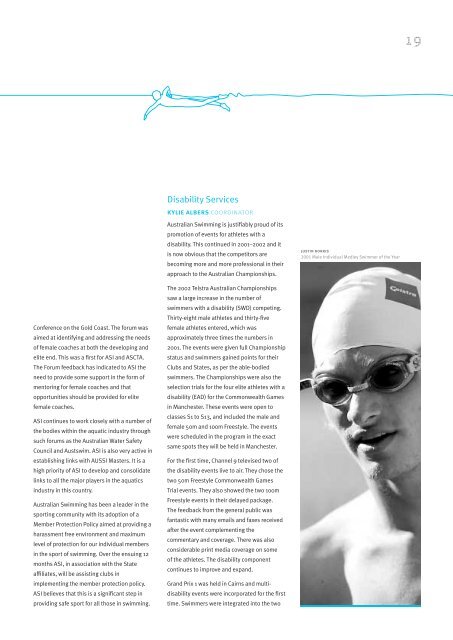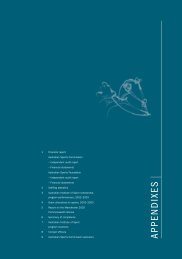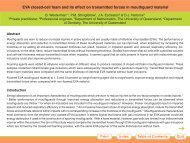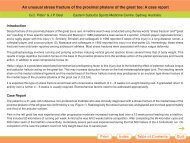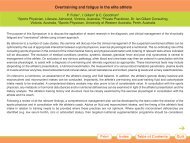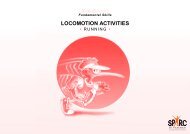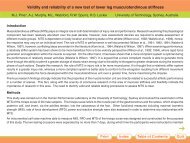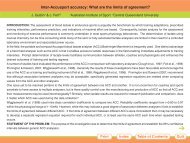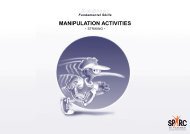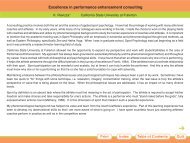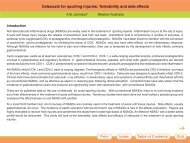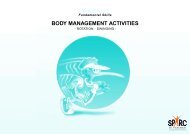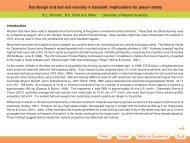australian swimming 93rd annual report 2001/2002
australian swimming 93rd annual report 2001/2002
australian swimming 93rd annual report 2001/2002
You also want an ePaper? Increase the reach of your titles
YUMPU automatically turns print PDFs into web optimized ePapers that Google loves.
Conference on the Gold Coast. The forum was<br />
aimed at identifying and addressing the needs<br />
of female coaches at both the developing and<br />
elite end. This was a first for ASI and ASCTA.<br />
The Forum feedback has indicated to ASI the<br />
need to provide some support in the form of<br />
mentoring for female coaches and that<br />
opportunities should be provided for elite<br />
female coaches.<br />
ASI continues to work closely with a number of<br />
the bodies within the aquatic industry through<br />
such forums as the Australian Water Safety<br />
Council and Austswim. ASI is also very active in<br />
establishing links with AUSSI Masters. It is a<br />
high priority of ASI to develop and consolidate<br />
links to all the major players in the aquatics<br />
industry in this country.<br />
Australian Swimming has been a leader in the<br />
sporting community with its adoption of a<br />
Member Protection Policy aimed at providing a<br />
harassment free environment and maximum<br />
level of protection for our individual members<br />
in the sport of <strong>swimming</strong>. Over the ensuing 12<br />
months ASI, in association with the State<br />
a÷liates, will be assisting clubs in<br />
implementing the member protection policy.<br />
ASI believes that this is a significant step in<br />
providing safe sport for all those in <strong>swimming</strong>.<br />
Disability Services<br />
kylie albers coordinator<br />
Australian Swimming is justifiably proud of its<br />
promotion of events for athletes with a<br />
disability. This continued in <strong>2001</strong>–<strong>2002</strong> and it<br />
is now obvious that the competitors are<br />
becoming more and more professional in their<br />
approach to the Australian Championships.<br />
The <strong>2002</strong> Telstra Australian Championships<br />
saw a large increase in the number of<br />
swimmers with a disability (SWD) competing.<br />
Thirty-eight male athletes and thirty-five<br />
female athletes entered, which was<br />
approximately three times the numbers in<br />
<strong>2001</strong>. The events were given full Championship<br />
status and swimmers gained points for their<br />
Clubs and States, as per the able-bodied<br />
swimmers. The Championships were also the<br />
selection trials for the four elite athletes with a<br />
disability (EAD) for the Commonwealth Games<br />
in Manchester. These events were open to<br />
classes S1 to S13, and included the male and<br />
female 50m and 100m Freestyle. The events<br />
were scheduled in the program in the exact<br />
same spots they will be held in Manchester.<br />
For the first time, Channel 9 televised two of<br />
the disability events live to air. They chose the<br />
two 50m Freestyle Commonwealth Games<br />
Trial events. They also showed the two 100m<br />
Freestyle events in their delayed package.<br />
The feedback from the general public was<br />
fantastic with many emails and faxes received<br />
after the event complementing the<br />
commentary and coverage. There was also<br />
considerable print media coverage on some<br />
of the athletes. The disability component<br />
continues to improve and expand.<br />
Grand Prix 1 was held in Cairns and multidisability<br />
events were incorporated for the first<br />
time. Swimmers were integrated into the two<br />
justin norris<br />
<strong>2001</strong> Male Individual Medley Swimmer of the Year<br />
19


